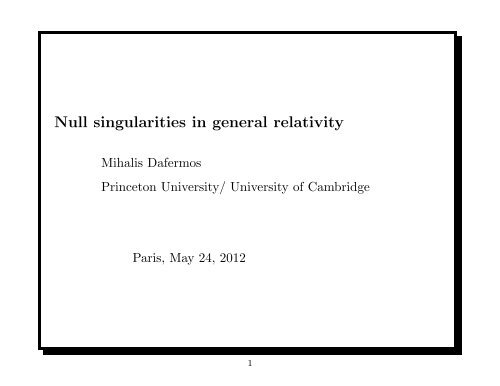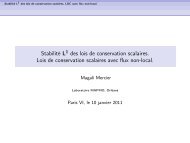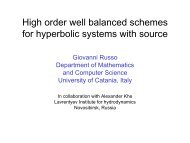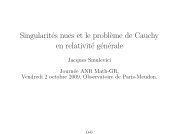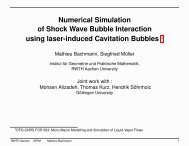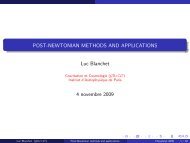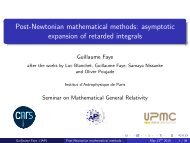Mihalis Dafermos - Philippe LeFloch
Mihalis Dafermos - Philippe LeFloch
Mihalis Dafermos - Philippe LeFloch
You also want an ePaper? Increase the reach of your titles
YUMPU automatically turns print PDFs into web optimized ePapers that Google loves.
Null singularities in general relativity<br />
<strong>Mihalis</strong> <strong>Dafermos</strong><br />
Princeton University/ University of Cambridge<br />
Paris, May 24, 2012<br />
1
Outline<br />
1. Schwarzschild, Reissner–Nordström/Kerr and the strong<br />
cosmic censorship conjecture<br />
2. The blue-shift effect in linear theory<br />
3. A fully non-linear model under symmetry<br />
4. The vacuum equations without symmetry<br />
2
1. Schwarzschild,<br />
Reissner–Nordström/Kerr and<br />
the strong cosmic censorship conjecture<br />
3
Schwarzschild<br />
M<br />
γ<br />
I +<br />
I +<br />
Σ<br />
The Schwarzschild spacetime is geodesically incomplete–there are<br />
observers–like poor γ–who live only for finite proper time. All such<br />
observers are torn apart by infinite tidal forces. The spacetime is<br />
inextendible as a Lorentzian manifold with C 0 metric.<br />
Is this prediction stable to arbitrary perturbation of initial<br />
data<br />
4
Reissner–Nordström 0
Strong cosmic censorship<br />
Conjecture (Strong cosmic censorship, Penrose 1972). For<br />
generic asymptotically flat initial data for the Einstein vacuum<br />
equations, the maximal Cauchy development is future inextendible<br />
as a suitably regular Lorentzian manifold.<br />
One should think of this conjecture as a statement of global<br />
uniqueness.<br />
6
The inextendibility requirement of the conjecture is true then in<br />
Schwarzschild, but false in Reissner–Nordström and Kerr for Q≠0,<br />
a≠0 respectively.<br />
Thus, within the class of explicit stationary solutions, it is<br />
extendibility that is generic, not inextendibility, which only holds<br />
with a=Q=0!<br />
Why would one ever conjecture then that strong cosmic<br />
censorship holds<br />
7
Blue-shift instability (Simpson–Penrose, 1972)<br />
A possible mechanism for instability is the celebrated blue-shift<br />
effect.<br />
CH + I +<br />
B<br />
i + i 0<br />
H +<br />
Σ<br />
A<br />
Simpson and Penrose argued heuristically that this is reflected in<br />
the blow-up of the derivatives of a linear test field on a<br />
Reissner–Nordström background.<br />
This suggests Cauchy horizon formation is an unstable<br />
phenomenon once a wave-like dynamic degree of freedom is allowed.<br />
8
While linear theory predicts blow up at the Cauchy horizonCH + ,<br />
in the full non-linear theory governed by the Einstein vacuum<br />
equations, one might expect that the non-linearities would kick in<br />
so as for blow-up to occur before the Cauchy horizon has the chance<br />
to form.<br />
The conclusion which was drawn from the Simpson–Penrose<br />
analysis was that for generic dynamic solutions of the Einstein<br />
equations, the picture would revert to Schwarzschild:<br />
M<br />
I +<br />
I +<br />
Σ<br />
9
The blue-shift effect in linear theory<br />
10
The simplest mathematical realisation of the Simpson–Penrose<br />
heuristic account of the blue shift instability can be given as a<br />
corollary of a general recent result on the Gaussian beam<br />
approximation on Lorentzian manifolds, due to Sbierski. This<br />
gives:<br />
Theorem 1 (Sbierski, 2012). In subextremal Reissner–Nordström<br />
or Kerr, let Σ be a two-ended asymptotically flat Cauchy surface<br />
and choose a spacelike hypersurfacẽΣ transverse toCH + , let<br />
E Σ [ψ], ẼΣ[ψ] denote the energy measured with respect to the<br />
normal of Σ,̃Σ, respectively.<br />
Then<br />
sup ẼΣ[ψ]=∞.<br />
ψ∈C ∞ ∶E Σ [ψ]=1<br />
11
On the other hand, the radiation emitted to the black hole from<br />
initially localised data should in fact decay and a priori this decay<br />
could compete with the blue-shift effect. We have, however:<br />
Theorem 2 (M.D. 2003). In subextremal Reissner–Nordström, for<br />
sufficiently regular solutions of ψ=0 of intially compact support,<br />
then if the spherical mean ψ 0 satisfies<br />
∣∂ v ψ 0 ∣≥cv −4 (1)<br />
along the event horizonH + , for some constant c>0 and all<br />
sufficiently large v, then ẼΣ[ψ]=∞.<br />
The lower bound(1) is conjecturally true for generic initial data of<br />
compact support, cf. Bicak, Gundlach–Price–Pullin, ...<br />
12
The blow-up given by the above theorem, if it indeed occurs is,<br />
however, in a sense weak!<br />
In particular, the L ∞ norm of the solution remains bounded.<br />
Theorem 3 (A. Franzen, 2013). In subextremal<br />
Reissner–Nordström with M>Q≠0, let ψ be a sufficiently regular<br />
solution of the wave equation Then<br />
∣ψ∣≤C<br />
globally in the black hole interior up to and includingCH + .<br />
The above result generalised a previous result (M.D. 2003)<br />
concerning spherically symmetric solutions.<br />
Theorem 3 can also now be generalised to Kerr in the full<br />
subextremal range∣a∣
The first input into the proof is an upper bound for the decay rate<br />
along the event horizonH + in Reissner–Nordström which can be<br />
obtained from the work of Blue.<br />
14
Having decay on the event horizon for ∂ v φ, one now needs to<br />
propagate estimates in the black hole interior.<br />
The interior can be partitioned into a red-shift regionR, a no-shift<br />
regionN, and a blue-shift regionB, separated by constant-r curves<br />
where r=r + −ǫ, r=r − +ǫ, respectively.<br />
B<br />
CH + i +<br />
C ′ in<br />
N<br />
R<br />
p<br />
H +<br />
15
One can pass a suitable logarithmic Eddington-Finkelstein-v<br />
distance into the blue-shift region at the expense of losing a<br />
polynomial power of decay.<br />
B<br />
CH + i +<br />
C ′ in<br />
N<br />
R<br />
p<br />
H +<br />
This brings us to a curve γ. The significance of this curve is that<br />
the spacetime volume of its future is finite.<br />
16
In the region following γ, one applies a vector field<br />
v p ∂ v +u p ∂ u<br />
in Eddington–Finkelstein coordinates, with p>1. In a regular<br />
coordinate V with V=0 at the Cauchy horizon, this is<br />
(logV) −p V∂ V +u p ∂ u .<br />
Using the compactness of the spacetime volume to the future of γ,<br />
one can close an energy estimate yielding the boundedness of the<br />
flux<br />
∫ S<br />
2 ∫ v p (∂ v φ) 2 +(1−2Mr+Q 2 r 2 )u p ∣∇/ψ∣ 2 r 2 dvdσ S 2<br />
The uniform boundedness of φ then follows from<br />
φ≤∫ ∂ v φ+data≤∫ v p (∂ v φ) 2 dv+∫ v −p dv+data,<br />
commutation with angular momentum operators Ω i , and Sobolev.<br />
<br />
17
If one “naively” extrapolates the linear behaviour of ψ=0 to the<br />
non-linear Ric(g)=0, where we think of ψ representing the metric<br />
itself in perturbation theory, whereas derivatives of ψ representing<br />
the Christoffel symbols, this suggests that the metric may extend<br />
continuously to the Cauchy horizon wheras the Christoffel symbols<br />
blow up, failing to be square integrable.<br />
On the other hand, if one believes the original intuition, then the<br />
non-linearities of the Einstein equations should induce blow-up<br />
earlier.<br />
Which of the two scenario holds<br />
18
Fully non-linear theory under symmetry<br />
19
The Einstein–Maxwell–(real) scalar field model<br />
under spherical symmetry<br />
A poor man’s model for the Einstein vacuum equations which<br />
allows for the study of this problem in spherical symmetry is that<br />
of a self-gravitating real-valued scalar field in the presence of a<br />
self-gravitating electromagnetic field.<br />
R µν − 1 2 g µνR=8π(T φ µν+T F µν)<br />
T φ µν=∂ µ φ∂ ν φ− 1 2 g µν∂ α φ∂ α φ<br />
T F µν= 1<br />
4π (gαβ F αµ F βν − 1 4 g µνF αβ F αβ )<br />
g ψ=0, ∇ µ F µν =0, dF=0<br />
20
(M,g,φ), g=−2Ω 2 dudv+r 2 dσ S 2<br />
∂ u ∂ v r=− Ω2<br />
4r − 1 r ∂ vr∂ u r+ 1 4 Ω2 r −3 Q 2 ,<br />
∂ u ∂ v logΩ 2 =−4π∂ u φ∂ v φ+ Ω2<br />
4r 2+ 1 r 2∂ vr∂ u r− Ω2 Q 2<br />
2r 4 ,<br />
∂ u (r∂ v φ)=−∂ u φ∂ v r,<br />
∂ u (Ω −2 ∂ u r)=−4πrΩ −2 (∂ u φ) 2 ,<br />
∂ v (Ω −2 ∂ v r)=−4πrΩ −2 (∂ v φ) 2 .<br />
21
CH +<br />
Theorem 4 (M.D. 2001, 2003). For arbitrary asymptotically flat<br />
spherically symmetric data for the Einstein–Maxwell–real scalar<br />
field system for which the scalar field decays suitably at spatial<br />
infinity i 0 , then if the charge is non-vanishing and the event<br />
horizonH + is asymptotically subextremal, it follows that the<br />
Penrose diagramme contains a subset which is as below<br />
i + i 0<br />
H +<br />
I +<br />
Σ<br />
whereCH + is a non-empty piece of null boundary. Moreover, the<br />
spacetime can be continued beyondCH + to a strictly larger manifold<br />
with C 0 Lorentzian metric, to which the scalar field also extends<br />
continuously.<br />
22
Like for the recent result of Franzen about the linear problem<br />
without symmetry, the proof of the above theorem requires in<br />
particular as an input the fact that suitable decay bounds are<br />
known for the scalar field along the horizonH + under the<br />
assumptions of the theorem, a statement which in turn was proven<br />
in joint work with Rodnianski, 2003.<br />
Assuming such a decay statement onH + for the more complicated<br />
Einstein–Maxwell–charged scalar field<br />
system–this is yet to be proven!–a version of Theorem 4 has<br />
recently been obtained by Kommemi.<br />
23
Theorem 5 (M.D. 2001, 2003). If a suitable lower bound on the<br />
decay rate of the scalar field on the event horizonH + is assumed<br />
(c.f. the discussion of formula(1)), then the non-empty piece of<br />
null boundaryCH + of Theorem 4 is in fact a weak null singularity<br />
on which the Hawking mass blows up identically. In particular, the<br />
metric cannot be continued beyondCH + as a C 2 metric, in fact, as<br />
a continuous metric with square-integrable Christoffel symbols. The<br />
scalar field cannot be extended beyondCH + as a H 1 loc function.<br />
This theorem confirmed the “mass inflation” scenario developed<br />
and studied by:<br />
Hiscock 1983, Poisson–Israel 1989, Ori 1990,<br />
Gundlach–Price–Pulin 1994, Brady–Smith 1995, Burko 1997<br />
24
The above results suggest that “inextendible as a Lorentzian<br />
manifold with continuous metric and with Christoffel<br />
symbols in L 2 loc<br />
” may be the correct formulation of “inextendible<br />
as a suitably regular Lorentzian metric” in the statement of strong<br />
cosmic censorship. This formulation is due to Christodoulou.<br />
This notion of inextendibility, though not sufficient to show that<br />
macroscopic observers are torn apart in the sense of a naive Jacobi<br />
field calculation, ensures that the boundary of spacetime is singular<br />
enough so that one cannot extend the spacetime as a weak solution<br />
to a suitable Einstein–matter system. In this sense, it is sufficient to<br />
ensure a version of the “determinism” which SCC tries to enforce.<br />
25
The Einstein–Maxwell–real scalar field system is such that for the<br />
Maxwell tensor to be non-trivial, complete initial data necessarily<br />
will have two asymptotically flat ends–just like Schwarzschild and<br />
Reissner–Nordström.<br />
The theorems of the previous section only probed the structure of<br />
the boundary of spacetime in a neighbourhood of i + .<br />
What about the remaining boundary<br />
26
A preliminary result, using the fact that the matter model is, in<br />
language due to kommemi, “strongly tame”, implies that, if the<br />
initial data hypersurface Σ is moreover assumed to be “future<br />
admissible”, this boundary in general is as below:<br />
i +<br />
CH +<br />
M<br />
CH +<br />
i +<br />
I +<br />
I +<br />
Σ<br />
where in addition to the null boundary componentsCH + emanating<br />
from i + , on which r is bounded below (at this level of generality,<br />
these components are possibly empty, but are indeed non-empty if<br />
Theorem 4 applies), there is an (again, possibly empty!) achronal<br />
boundary on which r extends continuously to 0, depicted above as<br />
the thicker-shaded dotted line.<br />
27
Theorem 6 (M.D. 2011). Let(M,g,φ,F) be the maximal<br />
development of sufficiently small spherically symmetric<br />
perturbations of asymptotically flat two-ended data corresponding to<br />
subextremal Reissner–Nordström with parameters 0
The global bound<br />
r≥M RN −<br />
√<br />
M 2 RN −Q2 RN −ǫ<br />
holds for the area-radius r of the spherically symmetric spheres,<br />
where ǫ→0 as the ‘size’ of the perturbation tends to 0. Moreover,<br />
the metric extends continuously beyondCH + to a strictly larger<br />
Lorentzian manifold(̃M,̃g), makingCH + a bifurcate null<br />
hypersurface in ̃M. The scalar field φ extends to a continuous<br />
function on ̃M. All future-incomplete causal geodesics inMextend<br />
to enter ̃M.<br />
Finally, if φ satisfies the assumption of Theorem 5 on both<br />
components of the horizonH + , then the Hawking mass extends<br />
“continuously” to∞on all ofCH + . In particular,(M,g) is future<br />
inextendible as a spacetime with square integrable Christoffel<br />
symbols.<br />
29
Fully non-linear theory without<br />
symmetry<br />
30
One may thus conjecture:<br />
Conjecture 1 (Amos Ori). Let(M,g) be the maximal vacuum<br />
Cauchy development of sufficiently small perturbations of<br />
asymptotically flat two-ended Kerr data corresponding to<br />
parameters 0
Thus, according to the above conjecture, not only is there typically<br />
a portion of the singularity which is null, but, for solutions close to<br />
Kerr (our only family of explicit asymptotically flat solutions to the<br />
Einstein vacuum equations!), the entire singular boundary of<br />
spacetime is null.<br />
32
The first question one might ask is, can one construct weak null<br />
singularities for the vacuum and are they “stable” to perturbation<br />
This has recently been resolved in a remarkable new result of Luk<br />
Theorem 7 (Luk). Let us be given characteristic data for the<br />
Einstein vacuum equations defined on a bifurcate null hypersurface<br />
N out ∪N in , whereN out is parameterised by affine parameter<br />
u∈[0,u ∗ ), and the data are regular onN in while singular onN out ,<br />
according to<br />
∣ˆχ∣∼∣log(u ∗ −u)∣ −p ∣u ∗ −u∣ −1 , (2)<br />
for appropriate p>1. Then the solution exists in a region foliated<br />
by a double null foliation with level sets u, ū covering the region<br />
0≤u
The above theorem can be thought of as an extension of a recent<br />
result of Luk–Rodnianski on the propagation of impulsive<br />
gravitational waves.<br />
The setup was similar, but for impulsive gravitational waves, the<br />
shear ˆχ was bounded (but discontinuous at u ∗ ), enducing on the<br />
curvature component α a delta function singularity at u ∗ .<br />
In the new result of Luk, in contrast, ˆχ fails to be even in L 2 (in<br />
fact any L p , p>1), and thus the solutions cannot be extended<br />
beyond the singular front at u ∗ as weak solutions to the vacuum<br />
Einstein equations.<br />
Thus the situation for the new result is considerably more singular!<br />
34
In their theory of impulsive waves, Luk–Rodnianski also had a<br />
result on the interaction of two impulsive wave fronts. An analogue<br />
of this result for weak null singularities is:<br />
Theorem 8 (Luk). Now suppose bothN in ∪N out are<br />
parameterised by u∈[0,u ∗ ), u∈[0,u ∗ ), with u ∗ , u ∗ sufficiently<br />
small, and suppose initially that both<br />
∣ˆχ∣∼∣log(u ∗ −u)∣ −p ∣u ∗ −u∣ −1 , ∣ˆχ∣∼∣log(u ∗ −u)∣ −p ∣u ∗ −u∣ −1 , (3)<br />
Then the solution exists in[0,u ∗ )×[0,u ∗ ) and both bounds(3)<br />
propagate.<br />
35


